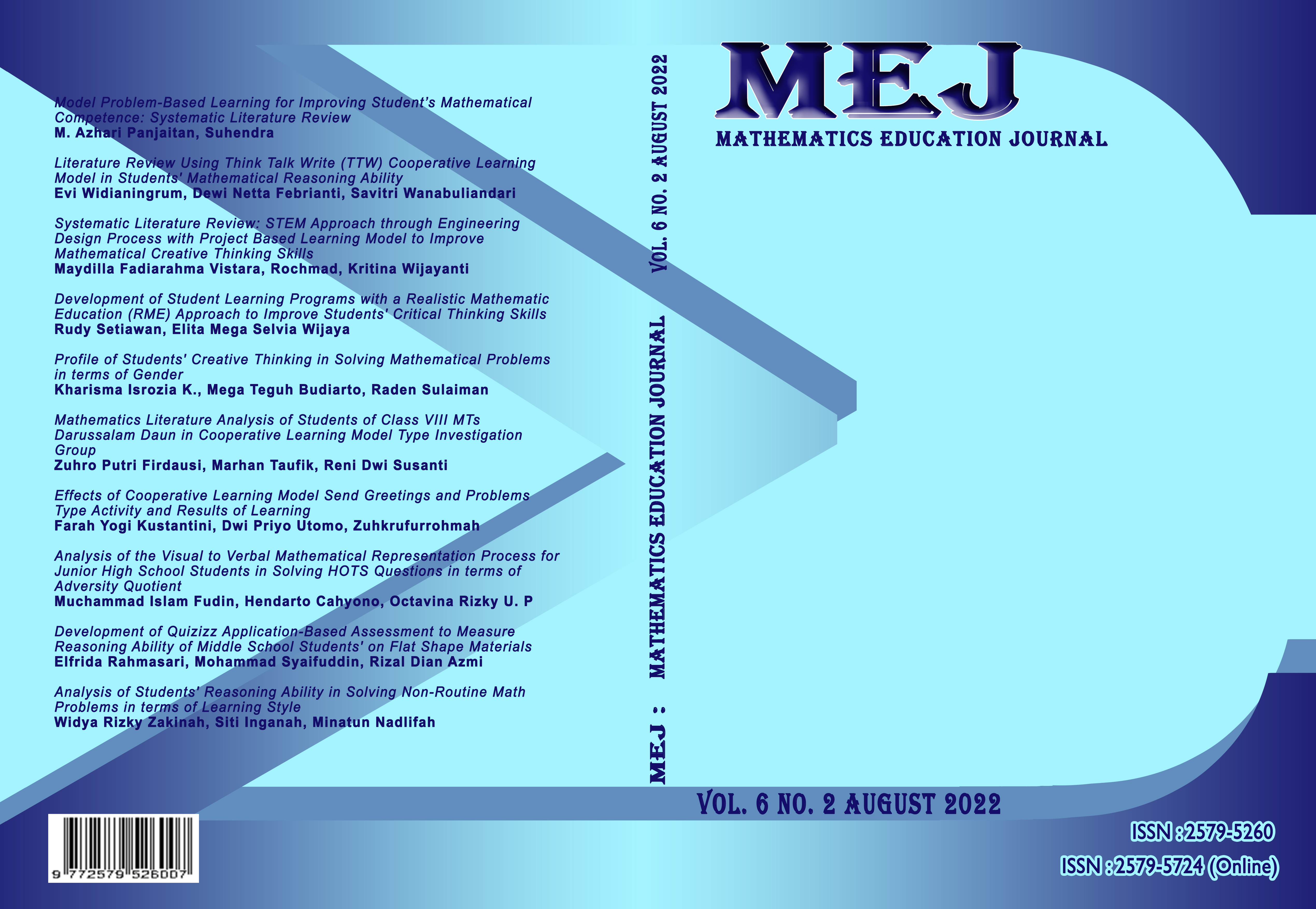Analysis of Students' Reasoning Ability in Solving Non-Routine Math Problems in terms of Learning Style
DOI:
https://doi.org/10.22219/mej.v6i2.23048Abstract
The purpose of this study is to describe students' mathematical reasoning abilities in solving non-routine problems in terms of learning styles. The type of research used is descriptive with qualitative data. The research subjects were students of class XI IPA. The instruments used are questionnaires, non-routine test questions, and interviews. The data to be taken are data on questionnaires, test questions, and interviews. The data obtained will then be analyzed in a descriptive-qualitative way. The results of this study are that 11th-grade students of MA Muhammadiyah 1 Plus Malang, have several learning styles, namely: visual, kinesthetic, and auditory, respectively: 67%️, 25%️, and 8%. Students with visual learning styles have fairly high reasoning abilities by meeting indicators such as 1) being able to present and make mathematical statements in writing well 2) being able to manipulate y-values, and 3) compiling solutions to existing problems. While students with kinesthetic learning styles, students meet reasoning ability indicators, including 1) writing mathematical statements well, and 2) manipulating target functions, then students with auditory learning styles only have one indicator of reasoning ability, namely: 1) creating and finding solutions to trouble well.
Downloads
References
Afif, A.M.S., Suyitno, H., W. (2016). Analisis kemampuan penalaran matematis siswa kelas VII ditinjau dari gaya belajar siswa pada. 2007, 328–336.
Aisyah, N. (2008). Pendekatan Pemecahan Masalah Matematika. Pembelajaran Matematika Sekolah Dasar, 1–34.
Anintya, Y. A., Pujiastuti, E., & Mashuri. (2017). Analisis Kemampuan Komunikasi Matematis Ditinjau dari Gaya Belajar Siswa Kelas VIII pada Model Pembelajaran Resource Based Learning. Unnes Journal of Mathematics Education, 6(1), 37–43.
Bachri, S. (2020). Analisis Kemampuan Penalaran Matematika Ditinjau Dari Gaya Belajar Siswa Pada Materi Logika Matematika. 3(2017), 54–67.
Damayanti, S. (2020). Analisis Kemampuan Penalaran Matematis Ditinjau Dari Gaya Belajar Siswa Kelas X AKL SMKN 1 Pulau Punjung Dharmasraya. 28–29.
Dana, I. (2019). KEMAMPUAN PENALARAN MATEMATIS SISWA DITINJAU DARI GAYA BELAJAR PADA MODEL PEMBELAJARAN MISSOURI MATHEMATICS PROJECT.
Darkasyi, M. (2014). Peningkatan Kemampuan Komunikasi Matematis dan Motivasi Siswa Dengan Pembelajaran Pendekatan Quantum Learning Pada Siswa SMP Negeri 5. 21–34.
Edimuslim, E., Edriati, S., & Mardiyah, A. (2019). Analisis Kemampuan Literasi Matematika ditinjau dari Gaya Belajar Siswa SMA. Suska Journal of Mathematics Education, 5(2), 95. https://doi.org/10.24014/sjme.v5i2.8055
Erdogan, A. (2015). Turkish Primary School Student’ Strategi in Solving a Non Routine Mathematical Problem and Some Implication For the Curriculum Design and Implementation. International Journal for Mathematics Teaching and Learning, 1–27.
Gordah, E. K. (2012). Masalah Matematis Peserta Didik Melalui Pendekatan Open Ended the Improving Teacher Effort on Ability Connection and Solve Math-. Jurnal Penidikan Dan Kebudayaan, 18(September), 264–279.
Jami, S., & Wijayanti, K. (2020). Kemampuan Penalaran Matematis pada Pembelajaran TTW ( Think Talk Write ) Ditinjau dari Gaya Belajar Siswa. PRISMA, Prosiding Seminar Nasional Matematika, 3, 599–604.
Mar’ah, A. (2015). Gaya Belajar dan Faktor Pengaruhnya Terhadap Pencapaian Prestasi Belajar IPA Terpadu Siswa Kelas VIII MTS Sultan Fatah Gaji Guntur Demak Tahun Pelajaran 2015/2016. Jurnal Empati, 1(1), 1–146.
Puspita, M. D., Prayito, M., & Sugiyanti, S. (2020). Analisis Kemampuan Penalaran Siswa SMA dalam Memecahkan Masalah Matematika Ditinjau dari Gaya Belajar Visual. Imajiner: Jurnal Matematika Dan Pendidikan Matematika, 2(2), 141–150. https://doi.org/10.26877/imajiner.v2i2.5776
Ramdani, S. (2019). Analisis Kemampuan Komunikasi Matematis Dalam Menyelesaikan Masalah Kontekstual Kelas XII MIPA Di SMA Negeri 1 Bone. In Αγαη (Vol. 8, Issue 2). https://doi.org/10.22201/fq.18708404e.2004.3.66178
Rizta, A., Zulkardi, Z., & Hartono, Y. (2015). Pengembangan Soal Penalaran Model Timss Matematika SMP. Jurnal Penelitian Dan Evaluasi Pendidikan, 17(2), 230–240. https://doi.org/10.21831/pep.v17i2.1697
Sahija, L. A. (2020). Analisis kemampuan penalaran siswa smp dalam menyelesaikan masalah matematika ditinjau dari gaya belajar. Universitas Muhammadiyah Malang.
Sayuri, M., & Yuhana, Y. (2020). SMP DITINJAU DARI GAYA BELAJAR tersebut , maka seseorang harus yang dilakukan oleh Priatna , diketahui adalah pada level penalaran ( reasoning ) dapat Nurhayati & Subekti ( 2017 ) yang. 1(4), 403–414.
Sizillia, N. (2018). Scaffolding Pada Penyelesaian Soal Non Rutin Telescopic. 2.
Sri Sumartini, T. (2015). Peningkatan Kemampuan Penalaran Matematis Siswa Melalui Pembelajaran Berbasis Masalah. Mosharafa, 5(1), 1–10.
Sugiyanto. (2014). Psikologi Pendidikan Diagnostik Kesulitan Belajar (Dkb). 274, 113–132.
Suprihatin, T. R., Maya, R., & Senjayawati, E. (2018). Analisis Kemampuan Penalaran Matematis Siswa SMP Pada Materi Segitiga dan Segiempat. Jurnal Kajian Pembelajaran Matematika, 2(1), 10.
Widayah, shofia nur. (2016). Pengaruh Gaya Belajar Siswa Terhadap Hasil Belajar Pendidikan Kewarganegaraan Di Sdn Gugus Dr. Cipto Mangunkusumo Kabupaten Pati. Pendidikan Guru Sekolah Dasar Fakultas Ilmu Pendidikan Universitas Negeri Semarang, 1–124.
Zubaidah, S. (2016). Keterampilan Abad Ke-21: Keterampilan Yang Diajarkan Melalui Pembelajaran. Seminar Nasional Pendidikan, 2(2), 1–17
Downloads
Published
Issue
Section
License
Copyright (c) 2022 Widya Rizky Zakinah, Siti Inganah, Minatun Nadlifah

This work is licensed under a Creative Commons Attribution-ShareAlike 4.0 International License.
Authors who publish with MEJ (Mathematics Education Journal) agree to the following terms:
For all articles published in MEJ, copyright is retained by the authors. Authors give permission to the publisher to announce the work with conditions. When the manuscript is accepted for publication, the authors agree to automatic transfer of the publishing right to the publisher.
Authors retain copyright and grant the journal right of first publication with the work simultaneously licensed under a Creative Commons Attribution-ShareAlike 4.0 International License that allows others to share the work with an acknowledgment of the work's authorship and initial publication in this journal.
Authors are able to enter into separate, additional contractual arrangements for the non-exclusive distribution of the journal's published version of the work (e.g., post it to an institutional repository or publish it in a book), with an acknowledgment of its initial publication in this journal.
Authors are permitted and encouraged to post their work online (e.g., in institutional repositories or on their website) prior to and during the submission process, as it can lead to productive exchanges, as well as earlier and greater citation of published work (See The Effect of Open Access).

This work is licensed under a Creative Commons Attribution-ShareAlike 4.0 International License.










